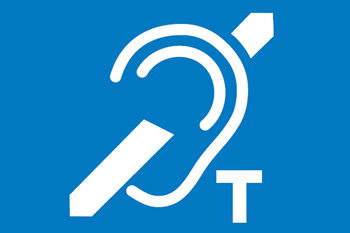A hearing loop delivers clearer sound directly to hearing aid devices for the hearing impaired
Click the link below to jump to the section.
A hearing loop system substantially reduces most background noise and greatly improves understanding of speech and music.
⬆️ Return to the top of the page
Using a pre-install wired loop within a room, called an induction loop system, which magnetically transmits sound to hearing aids and cochlear implants equipped with a receiver in the individual user's hearing device. Additionally, the sound received is customized by each user's unique settings on their hearing device to achieve optimum hearing for that person.
⬆️ Return to the top of the page
A hearing loop is installed in the Galloway meeting room in KWR Hall, Bush 202, Bush Auditorium.
The "Hearing Loop" symbol is displayed at the front right of the classroom near the podium.

⬆️ Return to the top of the page
To use a hearing loop, you need to adjust a setting on your hearing aids. Please note: not all hearing aids have this feature.
- Enter the room and sit closer to the middle than the edge.
The hearing loop may not work as well if you're on the border of the room.
- Turn your hearing aid to the "T" setting.
T stands for "telecoil" which translates the signal from the loop into audio in your hearing aid.
- If your hearing aids have manual volume settings, adjust the volume until the audio comes through clearly.
If you have arrived early, you may need to ask a presenter to speak into a live microphone to test.
⬆️ Return to the top of the page
- Call the Help Desk (407-628-6363):
- If we cannot get your hearing aids to connect, we can bring an external headset that connects to the hearing loop so you can still hear the event and be able to participate!
- If your hearing aids DO work with other hearing loops, share your hearing aid details with us - brand and model - and we'll follow up with our vendor for help adjusting the system
- If your hearing aids do NOT work with other hearing loops, here are details to check with your audiologist before the next session you attend in a hearing-loop-enabled room:
- Not all hearing aids have the telecoil (T) setting; ask your audiologist if your hearing aids have the telecoil capability.
- Sometimes the telecoil setting is not activated; ask your audiologist to ensure this feature is enabled on your hearing aids.
⬆️ Return to the top of the page
Teaching and Learning Tips are here to provide suggestions for the Instructor and student on how to get the most out of this technology.
- Repeat the question.
- Many times when a student asks a question, other students cannot hear what was asked as only the instructor has a microphone.
- Repeating the question will help all students understand and be better prepared to hear the answer.
- Keep background noise to a minimum.
- The smallest of noises can be amplified by hearing aid devices and cause the speaker's voice to be lost in the background.
- Minimize opening of windows, side conversations, pencil sharpening, loud electric fans/AC units, moving chairs/furniture around, etc. while class is in session.
- Be expressive.
- Keep in mind that the deaf and hard-of-hearing rely on visual cues to gather information, even with hearing aid devices.
- Communication through body language, hand jesters, and other visual expressions will help to convey your message.
⬆️ Return to the top of the page
For More Information
- Students with disabilities are encouraged to contact Accessibility Services for further accommodations.
- For more information please contact:
⬆️ Return to the top of the page